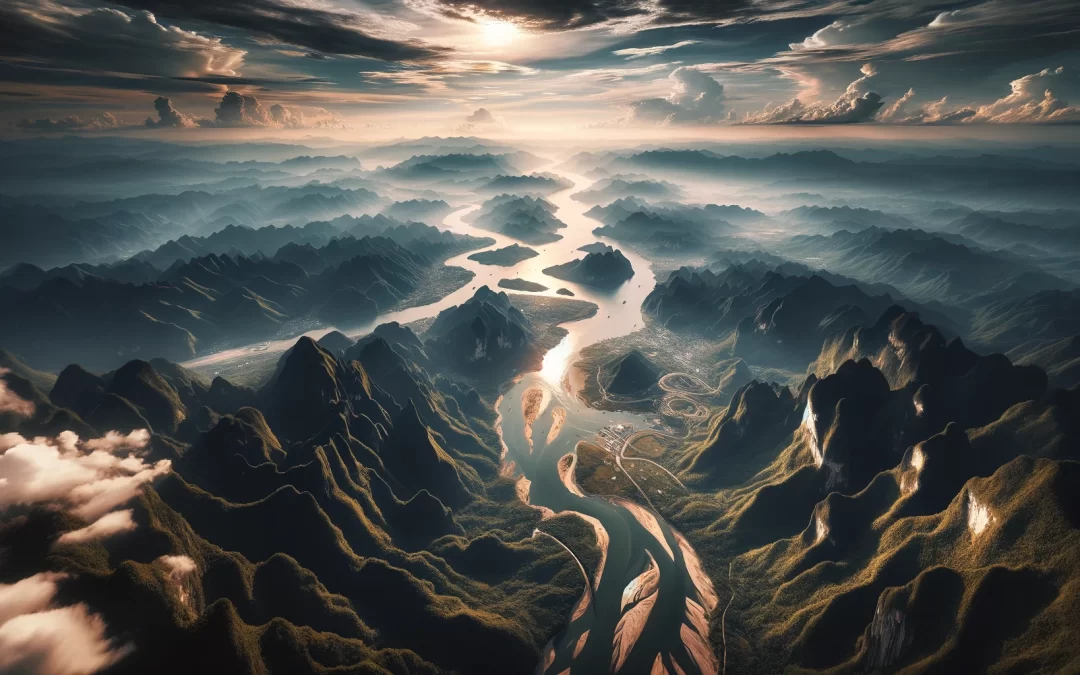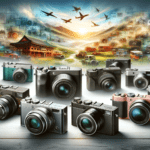1. DJI Mavic Air 2 (Amazon)
- Key Features: 48MP photos, 4K/60fps video, 34-minute flight time, 240-minute remote battery life, Advanced Pilot Assistance Systems
- Pros: High-resolution imaging, extended flight duration, obstacle avoidance technology, compact and foldable design, intelligent shooting modes
- Cons: Requires frequent firmware updates, relatively high price, can be noisy in flight
- Description: The DJI Mavic Air 2 stands out as a powerhouse of aerial photography, perfectly balancing portability and high-quality imaging. Its 48MP sensor captures breathtaking photos, while 4K video at 60fps ensures your travel memories are vividly documented. With a generous flight time and advanced safety features, it’s designed for both seasoned pilots and newcomers. The foldable design makes it an ideal travel companion, fitting easily into a backpack. Despite its few drawbacks, such as the need for regular updates and its flight noise, its performance and capabilities make it a top choice for travel enthusiasts looking to elevate their photography game.
2. Autel Robotics EVO Lite+ (Amazon)
- Key Features: 50MP photos, 6K video, 40-minute flight time, 3-axis gimbal, Dynamic Track 2.1
- Pros: Superior image quality, long flight time, advanced tracking features, compact design, excellent low-light performance
- Cons: Limited third-party accessory options, higher price point, occasional app glitches
- Description: The Autel Robotics EVO Lite+ is a marvel in the travel drone category, offering stunning 50MP photos and 6K video capabilities. Its extended flight time and robust tracking technology allow users to capture dynamic and intricate shots with ease. The drone’s compactness does not compromise its performance, especially in low-light conditions, making it perfect for dawn and dusk adventures. While its ecosystem may not be as vast as DJI’s, and the price sits on the higher end, the EVO Lite+’s unparalleled image quality and reliability make it a worthy investment for serious aerial photographers.
3. DJI Mini 2 (Amazon)
- Key Features: 12MP photos, 4K video, 31-minute flight time, 225-minute remote battery life, Level 5 wind resistance
- Pros: Ultra-lightweight and portable, easy to fly for beginners, impressive image quality for its size, strong wind resistance, affordable
- Cons: No obstacle avoidance, limited advanced features compared to larger models, the 12MP sensor might not satisfy professional photographers
- Description: The DJI Mini 2 is a game-changer for travelers who prioritize portability without sacrificing image quality. Weighing just under 250 grams, it bypasses drone registration requirements in many countries, making it ideal for international travel. Despite its small size, it packs a punch with 4K video capability and strong wind resistance, ensuring stable flights in diverse conditions. While it lacks some advanced features found in more expensive drones and has no obstacle avoidance, its affordability and ease of use make it a fantastic option for beginners and those on the go.
4. Skydio 2 (Amazon)
- Key Features: 12MP photos, 4K/60fps video, 23-minute flight time, Autonomy Engine, obstacle avoidance
- Pros: Best-in-class obstacle avoidance, autonomous flight capabilities, Made in the USA, high frame rate video, durable build
- Cons: Shorter flight time compared to competitors, limited global availability, higher learning curve for manual controls
- Description: The Skydio 2 excels in autonomous flight and obstacle avoidance, setting a new standard for drone safety and intelligence. Its Autonomy Engine enables it to navigate complex environments with ease, making it ideal for adventure sports and challenging terrains. While its flight time is on the lower side, the peace of mind and unique shots it can achieve autonomously are unmatched. The Skydio 2’s emphasis on safety and innovation makes it a standout choice for tech-savvy travelers and those engaging in dynamic outdoor activities.
5. Parrot Anafi (Amazon)
- Key Features: 21MP photos, 4K HDR video, 25-minute flight time, 180-degree tilt gimbal, USB-C charging
- Pros: High-resolution imaging, direct USB-C charging, unique gimbal tilt feature, lightweight and portable, quiet operation
- Cons: Less robust in high winds, slower customer service, lacks internal storage
- Description: The Parrot Anafi offers a compelling blend of portability and imaging prowess, with its 21MP sensor and 4K HDR video capabilities. Its unique 180-degree gimbal enables creative angles and shots that other drones can’t match. The convenience of USB-C charging and its quiet flight make it a discreet companion for travel photography. Though it may struggle in strong winds and lacks the build quality of higher-end models, the Anafi remains a versatile and valuable tool for capturing stunning aerial views on the go.
6. DJI Mavic 2 Pro (Amazon)
- Key Features: 20MP Hasselblad camera, 4K/30fps video, 31-minute flight time, Omnidirectional Obstacle Sensing, Adjustable Aperture
- Pros: Professional-grade image quality, advanced obstacle sensing, adjustable aperture for better control over exposure, robust design, reliable performance
- Cons: Higher price tag, heavier than ultra-light models, complex features may overwhelm beginners
- Description: The DJI Mavic 2 Pro is a professional’s dream, featuring a 20MP Hasselblad camera that ensures exceptional image quality with rich detail and color accuracy. Its adjustable aperture and advanced obstacle sensing capabilities provide unparalleled control and safety in flight. Though its price and complexity may deter some, the Mavic 2 Pro is unmatched in performance and durability, making it a top choice for serious photographers and videographers seeking the best aerial shots during their travels.
7. DJI Air 2S (Amazon)
- Key Features: 20MP photos, 5.4K video, 31-minute flight time, Advanced Pilot Assistance Systems, 1-inch sensor
- Pros: Exceptional image quality, large sensor for low light performance, comprehensive obstacle avoidance, versatile shooting modes, compact design
- Cons: Pricey, occasional connectivity issues, no side sensors for obstacle avoidance
- Description: The DJI Air 2S combines high-end imaging capabilities with user-friendly features, making it a versatile drone for both professionals and hobbyists. Its 1-inch sensor dramatically improves low light performance, capturing stunning aerial shots at dawn or dusk. With comprehensive safety features and a compact, foldable design, it’s an excellent travel companion. Although it’s on the pricier side and lacks side obstacle sensors, the Air 2S’s overall performance and versatility justify the investment for those seeking top-tier aerial photography capabilities.
8.Hubsan Zino Pro (Amazon)
- Key Features: 4K video, 23-minute flight time, Panorama photography, Image tracking, Removable lens
- Pros: Affordable, removable lens for flexibility, good for beginners, panorama shooting mode, decent flight time
- Cons: Less stable in windy conditions, limited range compared to higher-end models, slower customer support
- Description: The Hubsan Zino Pro is a budget-friendly option that doesn’t skimp on features, offering 4K video, panorama photography, and image tracking. Its removable lens system adds a layer of versatility not commonly found in drones at this price point. While it may not have the range or stability of more expensive models, its affordability and feature set make it an excellent entry point for hobbyists and travelers looking to dip their toes into aerial photography without breaking the bank.
9. FIMI X8 SE 2020 (Amazon)
10. PowerVision PowerEgg X Wizard (Amazon)
- Key Features: 4K/60fps video, Waterproof housing, AI Face Recognition, 30-minute flight time, Handheld mode
- Pros: Versatile use cases including wet conditions, innovative AI features, unique design, can be used as a handheld camera, good video quality
- Cons: Bulkier than other drones, limited flight time compared to some competitors, higher price point for the niche features
- Description: The PowerVision PowerEgg X Wizard stands out with its unique egg-shaped design and versatility, functioning as both a drone and a handheld camera. Its waterproof housing allows for use in all weather conditions, including rain and snow, making it ideal for adventurers and travelers facing diverse environments. AI Face Recognition and 4K/60fps video capability ensure high-quality footage, whether airborne or on the ground. Despite its bulk and somewhat limited flight time, the PowerEgg X Wizard’s innovative approach to aerial and hand-held photography makes it a fascinating option for those looking for more than just a drone.
FAQ’s
What are the benefits of using drones for travel photography and videography?
Using drones for travel photography and videography offers numerous benefits, transforming how travelers capture their experiences. Drones provide a unique aerial perspective, allowing for the capture of landscapes, architecture, and natural wonders from angles that were previously inaccessible or could only be achieved with expensive equipment. This bird’s-eye view can add a dramatic and professional quality to travel content. Additionally, drones are capable of shooting in high resolution, ensuring that the footage is not only breathtaking but also of high quality. They are particularly useful for creating dynamic videos that showcase the scale and beauty of a location. Moreover, drones have become increasingly compact and lightweight, making them convenient for travelers to carry without significantly adding to their luggage.
What are the key features to look for in a travel drone?
When selecting a travel drone, several key features should be considered to ensure it meets the needs of travel photography and videography. Portability is paramount; the drone should be lightweight and compact, ideally with foldable arms for easy packing. Battery life is another critical factor, as longer flights allow for more extensive shooting sessions. Look for drones that offer at least 20-30 minutes of flight time per battery. Image quality is essential, with many drones now offering 4K video recording and high-resolution stills. Stabilization technology, such as a gimbal, is crucial for smooth, cinematic shots. Additionally, consider drones with advanced flight modes, like follow-me, orbit, and waypoint navigation, to enhance your footage creatively. Lastly, check for any legal or regulatory compliance features, such as geofencing, which helps users adhere to local drone laws.
How do international laws and regulations affect traveling with drones?
International laws and regulations can significantly affect traveling with drones, as they vary widely from one country to another and are subject to change. Some countries require drone operators to register their drones and obtain a flying permit, while others have strict no-fly zones or completely ban the use of drones by tourists. It’s essential to research and understand the specific regulations of your destination country before traveling. This includes rules about drone operation, such as maximum altitude, distance from the operator, and no-fly zones, as well as any requirements for insurance or pilot certification. Failing to comply with local laws can result in fines, confiscation of the drone, or even legal action.
What tips can enhance the quality of travel drone footage?
To enhance the quality of travel drone footage, start by planning your shots in advance. Consider the time of day; early morning or late afternoon offers softer light and longer shadows, adding depth and texture to your footage. Experiment with different altitudes and angles to find unique perspectives. Use smooth and deliberate movements to create cinematic shots, avoiding sudden jerks or changes in speed. Incorporating subjects, such as people or vehicles, can add scale and interest. Additionally, be mindful of the environment and ensure your drone flights do not disturb wildlife or infringe on the privacy of locals. Editing plays a crucial role too; color grading and stabilizing post-shoot can significantly improve the final look of your footage.
How can travelers responsibly use drones to minimize environmental and social impacts?
Travelers can responsibly use drones by being mindful of their surroundings and adhering to ethical guidelines. Always respect privacy; avoid flying over private properties or taking photos and videos of people without their consent. Be aware of the environment; avoid disturbing wildlife and natural habitats. Follow local regulations and guidelines, which are often in place to protect sensitive areas and communities. Use drones at a respectful distance from historical sites, national parks, and religious places, as many have specific rules about drone use. By being considerate and informed, travelers can enjoy drone flying without negatively impacting the places they visit or their inhabitants.





